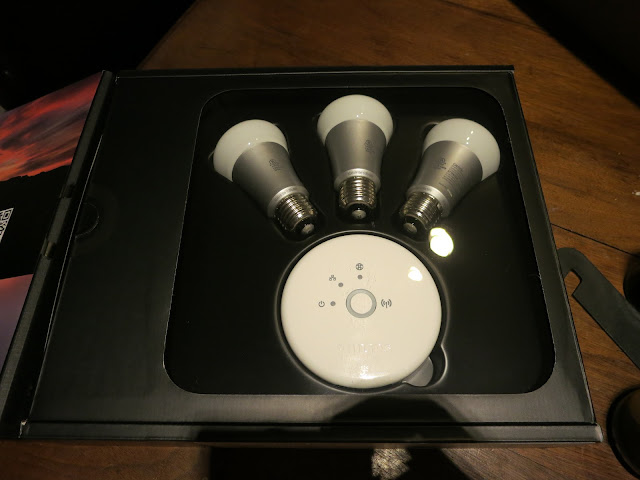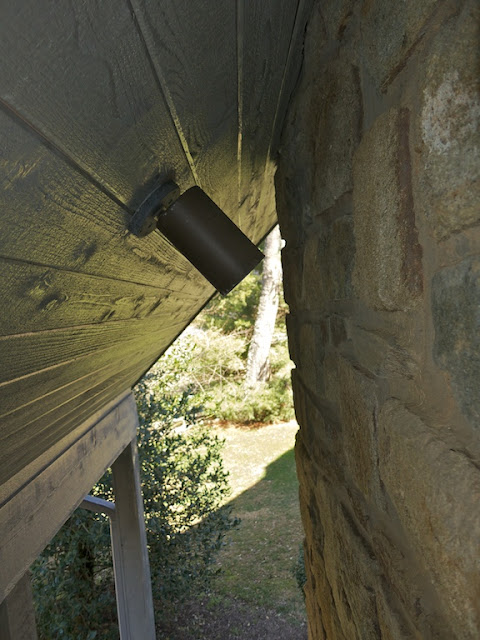A friend recently shot me a quick email asking if I was planning on getting the
Philips Hue, noting that it was currently for sale at the
Apple Store. I had never heard of it, so I had no immediate answer. It didn't take long to convince me; after checking out the product for a couple of minutes, I placed my order and then went off to Mexico for a planned vacation.
This was very much of the same concept that I had laid out in a
blog post four years ago. I was pretty excited to see the product in a commercial form. The Hue arrived yesterday, right after I got back from my trip; I had to open it right away (while eating dinner). Check out
this (much more complete) review on Geek.com if you are interested in an alternative perspective.
In the box
- 3 "connected" lightbulbs
- Zigbee hub
- Power adapter for zigbee hub
- Ethernet cable
Out of the box
Super easy setup, especially for how I was planning on using it. My plan was to put the three lightbulbs in the overhead light above our couch. One idea was that it could dim to red while watching a movie to provide a bit of light ("movie mode"), but not be disturbing our eyes to watch the movie (our son constantly complains if we have the lights on during a movie or TV show). This light is not far from my main 24-port ethernet switch (which still has roughly half its ports available).
I followed the instructions on the box:
- Screwed the lightbulbs in
- Turned the lightbulbs on
- Plugged in the zigbee hub (both ethernet and power)
- Downloaded the free Hue app for my iPhone
- Fired up Hue and began to play around
First Impressions
When I turned the light switch on, the bulbs lit up. So far so good. After connecting the Zigbee hub and loading the Hue app, the app directed me to push the button on the hub. I didn't get a great "click" sensation from doing so, but soon the app was off and running finding the light bulbs. I was then given a series of lighting "scenes" that I could adjust the lights to. It was pretty cool to mess around with them and they all seemed like their names suggested.
Movie Mode
Getting the lights in to movie mode took some tinkering with the app. Finally, I ended up using the feature to set the color to that of a portion of a picture (forcing me to find a picture in my photo library with a nice solid red). This worked except for the bulbs were a bit bright. After more messing around, I was able to control the bulbs from the brightness / tone configuration screen. There was no solid confirmation that my changes had been saved, but apparently when any change is made, it is kept.
Turning the lights off
When I was done watching MNF, I turned off the lights and left the room. But at the back of my mind, I was wondering what would happen the next time the lights were turned on. Fortunately, what I consider the "right thing" happened: they turned on to be normal white light bulbs. I like the flexibility that they will do funky stuff when you direct them to, but otherwise will just be normal lightbulbs. You don't need to always use your iPhone just to turn on the lights (that would be supremely annoying).
Brief Comment on the Technology
The bulbs communicate to the hub via
Zigbee. Zigbee is based on a mesh network concept that should mean that every additional bulb expands the reach of the network. Unfortunately from what I've read, Zigbee implementations tend to be proprietary and thus you won't be able to control this from a MiCasa Verde Vera or other home controller without a special extension package.
[Aside: this could be simpler than I'm suggesting depending on whether the Philips Zigbee hub has a nice API to interface with it. I would have signed up to be a developer to know more, but apparently they are still "developing for developers"] The Zigbee hub connects via wired ethernet (potentially a problem for your setup) to the rest of your home network (including your WiFi). Your phone connects via 802.11
whatever to your WiFi router.
My setup certainly does not test the bounds of possibilities here - the Zigbee hub was placed within 10 feet from the light fixture. Thus, I don't have anything useful to say about practical distance limitations for this setup.
One Step Beyond
First, some thoughts on my setup and then some criticisms. I have three bulbs in an overhead fixture. To the left and right of the TV there are four recessed lights for PAR 20s (two on each side) that the Philips Hue bulbs will fit in. At some point, I will spring to replace all of them to complete the room mood. Unfortunately, at the current price point, its going to be hard for me to do this. It would cost $60 x 4 = $240 just to finalize this. Ouch. For now, the Phillips Hue is just a fun toy. Someday, maybe more than that.
Improvements
It looks like Philips is towing the Open Source line for the moment. They are
looking for developers to extend the Hue setup. Hopefully, the developers will add these capabilities soon:
- Party Mode: Dance to the music. Seriously would have made for some cool commercials. Not sure what they were thinking by leaving it out. That said, how complex would this be? Could AirFoil/AirPlay be used (using an iPhone as a receiving speaker with an App running to convert the music to light pulses)?
- Grouping of bulbs: Perhaps there are a few interface features that I'm not aware of, but it seems like it'd be difficult to have too many bulbs distributed through
- Power meter: should be a trivial addition for the app to tell you instantaneously how much power the light bulb(s) is(are) using based on the current light settings.
- Room mapping (real scenes) and programming: It would be cool to be able to create more complex scenes that would be based on both interaction of paint color and a transitioning scene. Simple ideas would be to have a strobe effect (I have three bulbs in a circle on the overhead light) or a wave washing across a room (from left to right) or circling the room. Fancier still might be to have light patterns that could mess with your mind. I can see some OK Go!-like videos in the future here.
- Web-based (remote) control (oops - looks like this already exists - should have poked around the Philips Hue website a bit more.
- Different bulb shapes (this is supposedly in the works).
































